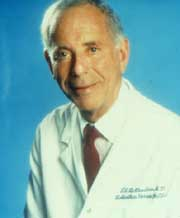Tension-free repair and Lichtenstein technique

Tension-free repair and Lichtenstein technique
Irving Lichtenstein, a surgeon in California, thought none of the sutured methods gave good results, and with 2 colleagues (see below) developed a new approach.
This quote from one of their articles – “The Lichtenstein open “tension-free” mesh repair of inguinal Hernias” – published in 1995 sums it up really nicely.
“All standard methods of hernia repair involve suturing together tissues which are not normally in apposition. This violates the basic surgical principle that tissue must never be approximated under tension and thus accounts for an unacceptable number of failures. A total reinforcement of the inguinal floor with a sheet of suitable biomaterial and the employment of a “tension-free” technique is a more effective approach. Since June 1984, 4,000 primary inguinal hernias have been repaired on an outpatient basis and under local anesthesia at the Lichtenstein Hernia Institute by the open “tension-free” technique using Marlex mesh. The patients were followed from 1 to 11 years by physician examination. The follow-up rate was 87%. There were four recurrences.”
The amazing thing is that these were carried out under local anaesthetic (still unusual even today), and were done as day cases – still aspired to in modern practice. Even more amazing is the follow up of 87% (most follow up studies are doing well if they get 50% follow up). Finally, and of course most amazing is the figure of 4 recurrences in 4,000 cases – 0.1%. No-one has achieved better.
So the term “tension- free” referred to the fact that the edges of the hole or hernia were not pulled together under tension as in the traditional inguinal hernia repairs and this is the method my colleagues and I used while we were at The British Hernia Centre.
Like Lichtenstein we did virtually all of the operations under local anaesthesia, with patients going home the same day, and the results were excellent.
Below – the article I wrote about him for the British Medical Journal
Click here to download in word format - lichtenstein-bmj




